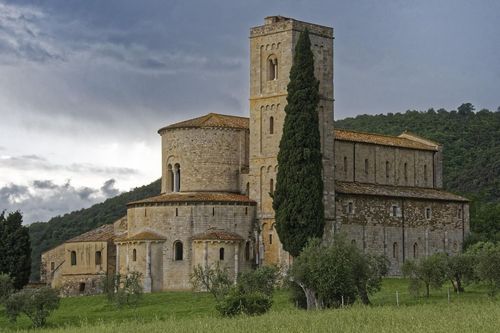Italian abbeys have played a fundamental role in the dissemination and preservation of viticulture in our country. As early as the medieval period, these places of worship and study transformed into true centers of wine production, contributing not only to shaping the surrounding rural landscape but also to passing down a millennia-old viticultural knowledge. With their imposing architectural presence and the discipline of monastic life, abbeys became custodians of agricultural and oenological traditions that remain an integral part of Italian identity today.
The Historical Context: Stability in a Turbulent Era
In an era marked by the fragmentation of power, barbarian invasions, and the fall of the Roman Empire, abbeys represented isolated hubs of stability and culture. Equipped with a solid organizational structure, they were able to ensure the continuity of vine cultivation in territories often affected by political instability and economic hardship. In this context, abbeys not only preserved an invaluable heritage of native grape varieties but also safeguarded ancient winemaking techniques, passed down from generation to generation, which today constitute a true cultural and oenological treasure.
Monastic Orders and the Value of Wine
The commitment to viticulture was particularly evident among monastic orders such as the Benedictines and Cistercians. For these orders, wine was much more than just a beverage: it was an essential symbol of the Eucharistic celebration and, at the same time, a fundamental sustenance for the monastic community. Often located in remote and isolated areas, abbeys relied on wine production to achieve food self-sufficiency and secure a stable and independent source of income. In this way, wine became an economic and cultural pillar, sustaining both the daily and spiritual life of the monks.
Abbey Wines Today: An Invaluable Oenological Heritage
Today, abbey wines represent an oenological heritage of inestimable value. Each glass tells a millennia-old story, interwoven with traditions, the land, and the identity of a place. The grapes, cultivated using traditional methods and often with organic or biodynamic approaches, reflect the authentic character of the terroir, while winemaking, meticulously curated, enhances the organoleptic characteristics that make each wine unique. This union between ancient knowledge and modern techniques has led to the creation of wines that are not merely beverages but true liquid works of art, capable of evoking emotions and narrating the time and effort of those who produced them.
Examples of Excellence: From Northern to Central-Southern Abbeys
Among the most renowned entities in the Italian wine scene is the Abbey of Novacella in Alto Adige, famous for its white wines, particularly those made from Sylvaner grapes. This native variety finds in Alto Adige an expression of unique aromatic and mineral complexity, which has brought fame to the monastic winery. In Tuscany, the Abbey of Monte Oliveto Maggiore stands out for the production of full-bodied and long-lived red wines, not only based on Sangiovese but also thanks to skillfully crafted blends that reflect the hilly character and winemaking tradition of the region. In Lazio, the Trappist nuns of Vitorchiano have created high-quality organic wines, resulting from a careful selection of grapes and an environmentally respectful vinification process, alongside typical products such as jams, honey, and olive oil, which complement the abbey's gastronomic offerings.
Innovation and Tradition: Events Dedicated to Abbey Wines
These examples demonstrate how abbey viticulture is not merely a legacy of the past but a thriving and continuously evolving production reality. In recent years, the growing interest in abbey wines has led to the creation of dedicated events, such as the "Vini d’Abbazia" exhibition. Held in the evocative cloister of the Abbey of Fossanova in Priverno, in the province of Latina, this initiative—now in its third edition—represents a unique opportunity to discover the stories, traditions, and flavors linked to monastic wine production. During the event, visitors can taste excellent products while immersing themselves in an atmosphere rich in history and culture, paying homage to centuries of dedication and passion for the land.
The "Vini d’Abbazia" exhibition is not just an oenological event but also a moment of reflection on the value of tradition and sustainability. Abbeys have always stood out for their commitment to preserving the land and promoting cultivation methods that respect the environment. This approach, which combines ancient knowledge with innovative techniques, has also found resonance in the contemporary world, where the rediscovery of roots and biodiversity represents a response to modern challenges.
A Legacy to Celebrate
The bond between abbeys and viticulture is, therefore, much more than just a historical matter: it embodies a model of land management based on care, continuity, and respect for nature. Italian abbeys have successfully transformed into authentic centers of excellence, capable of producing wines that speak to the heart and mind, telling stories of sacrifice, faith, and resilience. Each bottle of abbey wine is a journey through time, a gateway to a past rich in meaning, and a promise for the future.
